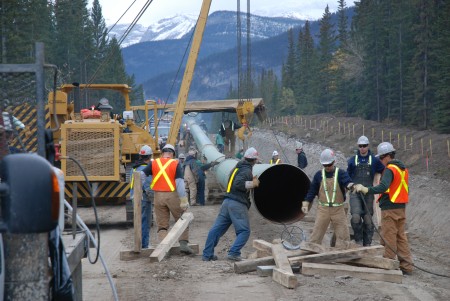May 21, 2016 – Approving a pipeline in Canada is no easy task. Particularly if the pipeline right-of-way crosses environmentally sensitive areas, or requires routing through lands in aboriginal claims dispute. And if the fossil fuel being moved to tidewater for export is of the heavy variety produced at oil sands plants then scrutiny is even more severe. So this week when Kinder Morgan (a United States-based energy company received a conditional green light from the country’s National Energy Board (NEB) it made headlines and raised potential flags.
The headlines talked about the 157 conditions the pipeline would need to meet to be constructed. The flags raised by environmentalists pointed to the lack of any reference to carbon offsets to balance the increased greenhouse gases associated with oil sands production volumes slated for the pipeline.
Now you would think in 157 conditions that one or two might talk about Canada’s commitment to reducing carbon emissions as per COP21. But in my reading of the summary ruling document no such reference appears. Doesn’t that seem odd?
Herein I quote from the NEB document re the conditions to be met for the project to proceed. The company must commit itself through:
- emergency preparedness and response
- protection of the environment
- consultation with those affected, including Indigenous communities
- socio-economic matters
- safety, and integrity of the pipeline
- commercial support for the Project prior to construction
- financial responsibility
See what I mean? Other than a generic statement about the environment nary a word is spoken about Canada’s commitment to fight climate change and global warming through a carbon reduction strategy. Instead the NEB stated in its ruling that the benefits outweigh the concerns. Those benefits include:
- increased access to diverse markets for Canadian oil;
- thousands of construction jobs and hundreds of long-term jobs directly related to the Project across Canada;
- the development of capacity of local and Indigenous individuals, communities and businesses;
- considerable benefit from direct spending on pipeline materials in Canada; and
- considerable government revenues from the Project.
And nowhere in the judgement is there mention of Kinder-Morgan’s environmental track record along the right of way the pipeline will follow. Unlike Keystone XL or Northern Gateway, much of this new pipeline will parallel an existing route. On that route Kinder-Morgan has been a poor steward of environmental safety. Read a posting I wrote back in May of 2014 describing numerous incidents of oil spills along this route. Considering one of the rationales for building the new capacity is to avoid spills that could occur by shipping oil by rail, the alternative. But Kinder Morgan has demonstrated repeatedly that “safety and integrity” have been less than reliable, and that “protection of the environment” has not proven to be one of the company’s great strengths.
What the pipeline will do is close to triple the daily capacity to ship oil over the proposed route. The NEB states that this increase matches the capacity increases expected from oil sands producers in the next four years. So what’s involved?
- The Trans Mountain Project will expand an existing pipeline system running between Edmonton, Alberta and Burnaby, British Columbia on the Pacific coast.
- It will increase capacity from 300,000 barrels per day to 890,000.
- Almost 90% of the route will parallel the existing right-of-way which means minimal new environmental disturbance those living along the route.
- Approximately 987 kilometers (about 600 miles) of new pipeline will have to built along with modifications to existing facilities such as pump stations and tanks.
- Part of the build will include reactivation of 193 kilometers (about 120 miles) of existing pipeline.
- In some locations new pump stations and tanks will be added and the Westridge Marine Terminal in Burnaby will also be expanded to deal with increased marine traffic.

So how does the NEB make a positive ruling without looking at Canada’s planned carbon budget based on its commitments made at COP21? Where is there mention that the suppliers of the dilbit (diluted heavy oil) that will run through this expanded pipeline are committed to offset the carbon emissions created in increased production through improved processes? Where is there a pledge to decrease the net carbon produced per barrel? Where is there plans for sequestration to capture the carbon at the point of production and bury it? Apparently that part of the environmental equation was not the purview of the NEB in their ruling. And that is a big mistake.
In 2013 Canada produced 726 megatons of greenhouse gas emissions. The federal government’s pledge at COP21 was to reduce that number by 2020 to 622 and by 2030 to 524 (roughly 30% less than the 2013 number). But with pipeline expansion and increased production capacity from oil sands projects in existence or anticipated to come on stream over the next four years, those numbers are a pipe dream unless the industry commits to technological innovation that removes the carbon emissions threat. To date only two sequestration projects are in operation in Canada – Quest, a Royal Dutch Shell venture and the Saskatchewan Boundary Dam. Between the two they represent a mere fraction of the requirement to offset the carbon emissions from increased oil sands production capacity over the short term. In the past without significant investment from government no oil sands producers have been prepared to invest in carbon capture on their own. Building a pipeline to give them access to new markets, to in effect reward them for not addressing climate change the one way they can do so meaningfully seems to be a preposterous step on the part of the NEB and the government.
The only hope is that among the 157 conditions imposed on Kinder Morgan, that one of them is the company be tasked with reducing its carbon footprint during both the construction and operation of the pipeline. And that Kinder Morgan extend the same requirement to its suppliers or refuse to transport their dilbit to Burnaby and overseas markets. Is this an unheard of practice in supply chain management? No. It is done all the time by major corporations practising social responsibility and sustainability. That should be a tenet of any agreement for the pipeline to proceed.









